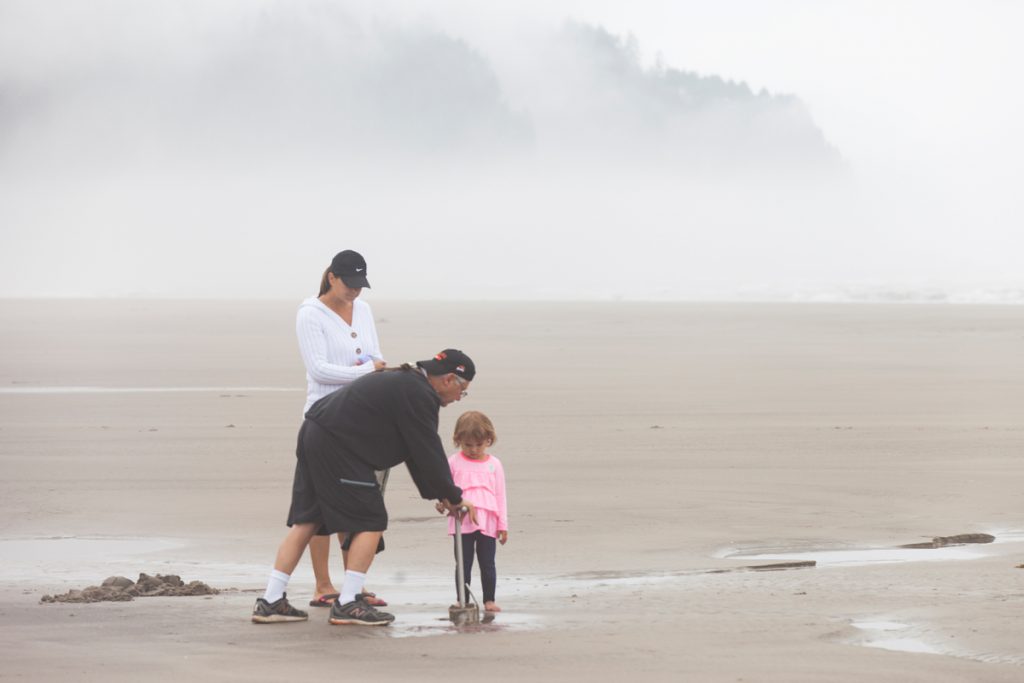If you want to take your family on an authentic Oregon Coast nature-based adventure, you ought to give clamming a try. Gear up with your rain jacket, a bucket, a shovel and some die-hard determination to discover something great—just beneath the surface. Digging for clams takes a little research and just the right timing. It is exhilarating, like digging for lost treasure.
Where to go clamming on Oregon’s Tillamook Coast?
Our favorite razor clamming spots along the Tillamook Coast include Netarts Spit, Tierra Del Mar and Cape Meares to the south; and Rockaway Beach, Short Sands Beach and Manzanita to the North.
Tillamook and Netarts bays are prime bay clamming grounds along the Tillamook Coast. There’s also a great spot in Garibaldi just below the long dock. Take the stairway near the pier down to the beach and walk toward the ocean on low tide. You’ll find both little necks and cockles here, and occasionally butter clams and gaper clams, as well.
When to go clamming on Oregon’s Tillamook Coast?
Your best bet is to go during a minus tide. Spring and summer months are when you’ll find daytime minus tides. If you go during a low or minus tide April through August, you’ve hit the mark.
What you need to know
Step 1: Clamming is regulated by the Oregon Department of Fish and Wildlife (ODFW). Find out from ODFW what kind of clams are available in the area you’re going to visit and what kind of tools are needed. (As of November 2016 razor clamming is closed on the Oregon Coast.)
Step 2: Check for any recreational shellfish closures with the Shellfish Hotline at 1-800-448-2474.
Step 3: Buy your $9 resident shellfish license; no license required for kids 12 and under.
Step 4: Identify when to go. You want a very low tide; minus tides are the best. Show up a couple of hours before the low tide for time to explore and find clams before the tide turns.
And there are several types of clams you can find on Oregon’s Tillamook Coast!
Bay clamming
If it’s bay clams you’re after, you’ve got two vast bays to explore. Both Tillamook and Netarts bays have populations of cockles, soft shell clams, gapers, butter clams and little necks. To learn about bay clamming and see some great visuals of the clam varieties, see Grant’s Getaways adventures in bay clamming in the Tillamook Bay.
Cockles
Daily limit: 20, in aggregate with other bay clams
Harvesting cockles is an increasingly popular Oregon Coast activity. Cockles are easy to find, as you rake the sand or sandy mud for them; they are only 1” to 2” below the surface. Sometimes you can see their show: it looks like two holes about ½” apart!
Soft Shell Clams
Daily limit: 36
To dig soft shell clams, you’ll need a garden shovel or short-handed spade. These clams are found in the mud of the upper-bay regions. Look for “show” holes and dig down beside them.
Gapers/Horsenecks/Blues Clams
Daily limit: 12, out of a total of 20 bay clams
To dig gapers, Oregon’s largest common clam, you’ll need a shovel. Look for a long, oblong show. Try sticking your finger in the show and if it’s a clam, you will feel its neck retract—that’s when you start digging! Dig quickly down deep beside it; find the clam from the side.
Butter/Quahogs/Washington Clams
Daily limit: 20, in aggregate with other bay clams
Butter clams live in high salinity, mud or sandy areas. These clams have a distinctive rectangular show. Using a shovel or short handled small garden spade, dig next to the show and reach in gently with your hand or shovel to unearth the clam.
Little Necks/Steamer Clams
Daily limit: 20, in aggregate with other bay clams
Little necks are those tasty bivalves served as “steamer clams” in restaurants. They are small and live only about 1” to 8” beneath the surface. With a small shovel or rake, scratch through the gravel and rocks to harvest them. Little necks are almost solely found in bays, in rocky or gravel areas.
